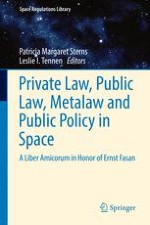
2016 | OriginalPaper | Chapter
Small Is Beautiful? Legal Challenges of Small Satellites
Author : Irmgard Marboe
Published in: Private Law, Public Law, Metalaw and Public Policy in Space
Publisher: Springer International Publishing
Activate our intelligent search to find suitable subject content or patents.
Select sections of text to find matching patents with Artificial Intelligence. powered by
Select sections of text to find additional relevant content using AI-assisted search. powered by